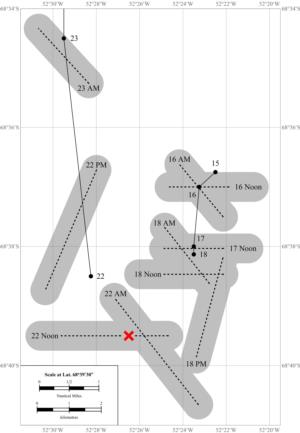
NavList:
A Community Devoted to the Preservation and Practice of Celestial Navigation and Other Methods of Traditional Wayfinding
From: Robin Stuart
Date: 2022 Feb 23, 07:21 -0800
Dale,
I am not in contact with Endurance22 but believe they have our preprint https://NavList.net/imgx/OccultationCEPreprint.pdf and have adjusted their search strategy accordingly. That paper is focussed on the longitude which is where the greatest uncertainties lie. They also have our previous paper https://www.cambridge.org/core/journals/journal-of-navigation/article/on-the-location-of-shackletons-vessel-endurance/5F1AD80B3445C2653F1C24EAD4B7460D/share/af04c02d4ebde51ac7addc3ea1fc34026f1a589c which was also in the hands of the 2019 Weddell Sea Expedition. They did cite us in their publication https://www.cambridge.org/core/journals/antarctic-science/article/seafloor-and-seaice-conditions-in-the-western-weddell-sea-antarctica-around-the-wreck-of-sir-ernest-shackletons-endurance/0D4511F2859986967E6F53490F27F0D3 but they had planned to search such a vast area that any guidance that we had to offer was more or less irrelevant. In the event their Autonomus Underwater Vehicle (AUV) was lost and no information was obtained.
As far as the latitude of Endurance goes it is very hard to see how it could possibly be to the north of the so called Endurance Memorial position. That is based on the noon sight on of 22 November 1915. Endurance sank at 5pm the evening before and entries in various diaries indicate that over the intervening 19 hour period the wind was blowing with a sustained component from the south. The diary of quartermaster Orde-Lees is in the Rauner Special Collections Library at Dartmouth College. Some of it has been transcribed online https://sites.dartmouth.edu/library/2016/08/25/shackletons-endurance-expedition-a-crewmans-view-40/ . I have examined the original manuscript and found that on 22 November he writes
Colder & a welcome change from the prolonged thaw. A moderate southerly wind also bodes well, if maintained though our "position" today showed that as yet we were neither north nor west of where we were three days ago; but we have been unable to get a "sight" since then & may have made some southing in the meantime which has to be recovered before any improvement is discernible. Anyhow the pack is opening out all around and things look hopeful though we are far from being as far north as we had hoped by this date.
In our previous paper we plotted Lines of Position (LoP) from Worsley's sights as recorded in his log. It might be interesting to plot the positions of Agulhas II on the attached chartlet. I wonder if the AIS records available in numerical form.
Robin Stuart







